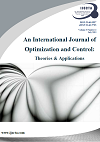Simultaneous model spin-up and parameter identification with the one-shot method in a climate model example
DOI:
https://doi.org/10.11121/ijocta.01.2013.00144Keywords:
Algorithmic differentiation, bounded retardation, climate model, ï¬xed point iteration, parameter identiï¬cationAbstract
We investigate the Oneshot Optimization strategy introduced by Hamdi and Griewank for the applicability and efficiency to identify parameters in models of the earth's climate system. Parameters of a box model of the North Atlantic Thermohaline Circulation are optimized with respect to the fit of model output to data given by another model of intermediate complexity. Since the model is run into a steady state by a pseudo time-stepping, efficient techniques are necessary to avoid extensive recomputations or storing when using gradient-based local optimization algorithms. The Oneshot approach simultaneously updates state, adjoint and parameter values. For the required partial derivatives, the algorithmic/automatic differentiation tool TAF was used. Numerical results are compared to results obtained by the BFGS-quasi-Newton method.Downloads
References
Griewank, A., Evaluating Derivatives: Principles and Techniques of Algorithmic Differentiation. SIAM, Philadelphia, PA (2000).
Christianson, B., Reverse accumulation and implicit functions. Optimization Methods and Software, 9(4), 307–322 (1998). Crossref
Kaminski, T., Giering, R., and Voßbeck, M., Efficient sensitivities for the spin-up phase. Automatic Differentiation: Applications, Theory, and Implementations, Lecture Notes in Computational Science and Engineering, Springer, New York, 50, 283–291 (2005).
Hamdi, A. and Griewank, A., Reduced Quasi-Newton Method for Simultaneous Design and Optimization. Comput. Optim. Appl. online, Available at www.springerlink.com (2009).
Hamdi, A. and Griewank, A., Properties of an Augmented Lagrangian for Design Optimization. Optimization Methods and Software, 25(4), 645–664 (2010). Crossref
Ozkaya, E. and Gauger, N., Single-Step One-Shot Aerodynamic Shape Optimization. International Series of Numerical Mathematics, 158, 191–204 (2009).
Ta’asn, S., Pseudo-Time Methods for Constrained Optimization Problems Governed by PDE. ICASE Report No. 95-32 (1995).
Hazra, S. B. and Schulz, V., Simultaneous Pseudo-Timestepping for PDE-Model Based Optimization Problems. BIT Numerical Mathematics, 44, 457–472 (2004). Crossref
Pham, D. and Karaboga, D., Intelligent Optimisation Techniques: Genetic Algorithms, Tabu Search, Simulated Annealing and Neural Networks. Springer London, Limited (2012).
Ciric, L. B., A Generalization of Banach’s Contraction Principle. Proceedings of the American Mathematical Society, 45(2), 267–273 (1974). Crossref
Griewank, A. and Kressner, D., â€Time-lag in Derivative Convergence for Fixed Point Iterations. ARIMA Numero special CARI’04, 87–102 (2005).
Giering, R., Kaminski, T., and Slawig, T., Generating Efficient Derivative Code with TAF: Adjoint and Tangent Linear Euler Flow Around an Airfoil. Future Generation Computer Systems, 21(8), 1345–1355 (2005). Crossref
Bischof, C. H., Lang, B., and Vehreschild, A., Automatic Differentiation for MATLAB Programs. Proceedings in Applied Mathematics and Mechanics, 2(1), 50–53 (2003). Crossref
Griewank, A., Juedes, D., and Utke, J., Algorithm 755: ADOL-C: A Package for the Automatic Differentiation of Algorithms Written in C/C++. ACM Transactions on Mathematical Software, 22(2), 131–167 (1996). Crossref
Zickfeld, K., Slawig, T., and Rahmstorf, S., A low-order model for the response of the Atlantic thermohaline circulation to climate change. Ocean Dynamics, 54, 8–26 (2004). Crossref
Titz, S., Kuhlbrodt, T., Rahmstorf, S., and Feudel, U., On freshwater-dependent bifurcations in box models of the interhemispheric thermohaline circulation. Tellus A, 54, 89 – 98 (2002). Crossref
Rahmstorf, S., Brovkin, V., Claussen, M., and Kubatzki, C., CLIMBER-2: A climate system model of intermediate complexity. Part II: Model sensitivity. Clim. Dyn., 17, 735–751 (2001). Crossref
Zhu, C., Byrd, R. H., and Nocedal, J., LBFGS-B: Algorithm 778: L-BFGS-B, FORTRAN routines for large scale bound constrained optimization. ACM Transactions on Mathematical Software, 23(4), 550–560 (1997). Crossref
Downloads
Published
How to Cite
Issue
Section
License
Articles published in IJOCTA are made freely available online immediately upon publication, without subscription barriers to access. All articles published in this journal are licensed under the Creative Commons Attribution 4.0 International License (click here to read the full-text legal code). This broad license was developed to facilitate open access to, and free use of, original works of all types. Applying this standard license to your work will ensure your right to make your work freely and openly available.
Under the Creative Commons Attribution 4.0 International License, authors retain ownership of the copyright for their article, but authors allow anyone to download, reuse, reprint, modify, distribute, and/or copy articles in IJOCTA, so long as the original authors and source are credited.
The readers are free to:
- Share — copy and redistribute the material in any medium or format
- Adapt — remix, transform, and build upon the material
- for any purpose, even commercially.
- The licensor cannot revoke these freedoms as long as you follow the license terms.
under the following terms:
- Attribution — You must give appropriate credit, provide a link to the license, and indicate if changes were made. You may do so in any reasonable manner, but not in any way that suggests the licensor endorses you or your use.
- No additional restrictions — You may not apply legal terms or technological measures that legally restrict others from doing anything the license permits.
 This work is licensed under a Creative Commons Attribution 4.0 International License.
This work is licensed under a Creative Commons Attribution 4.0 International License.












